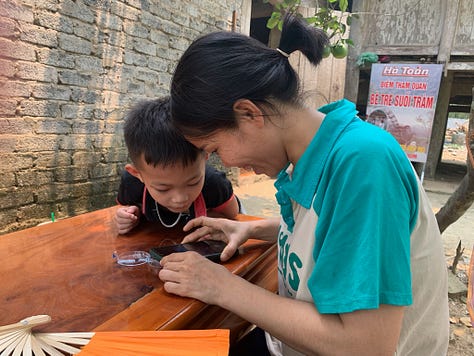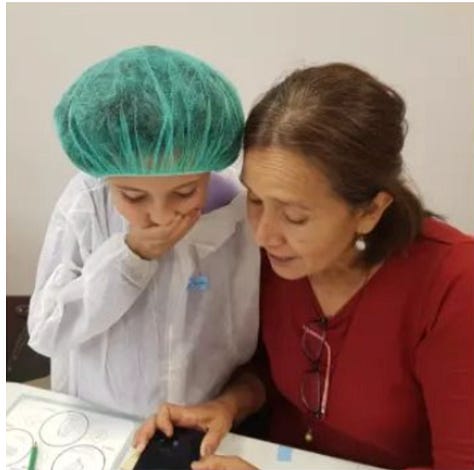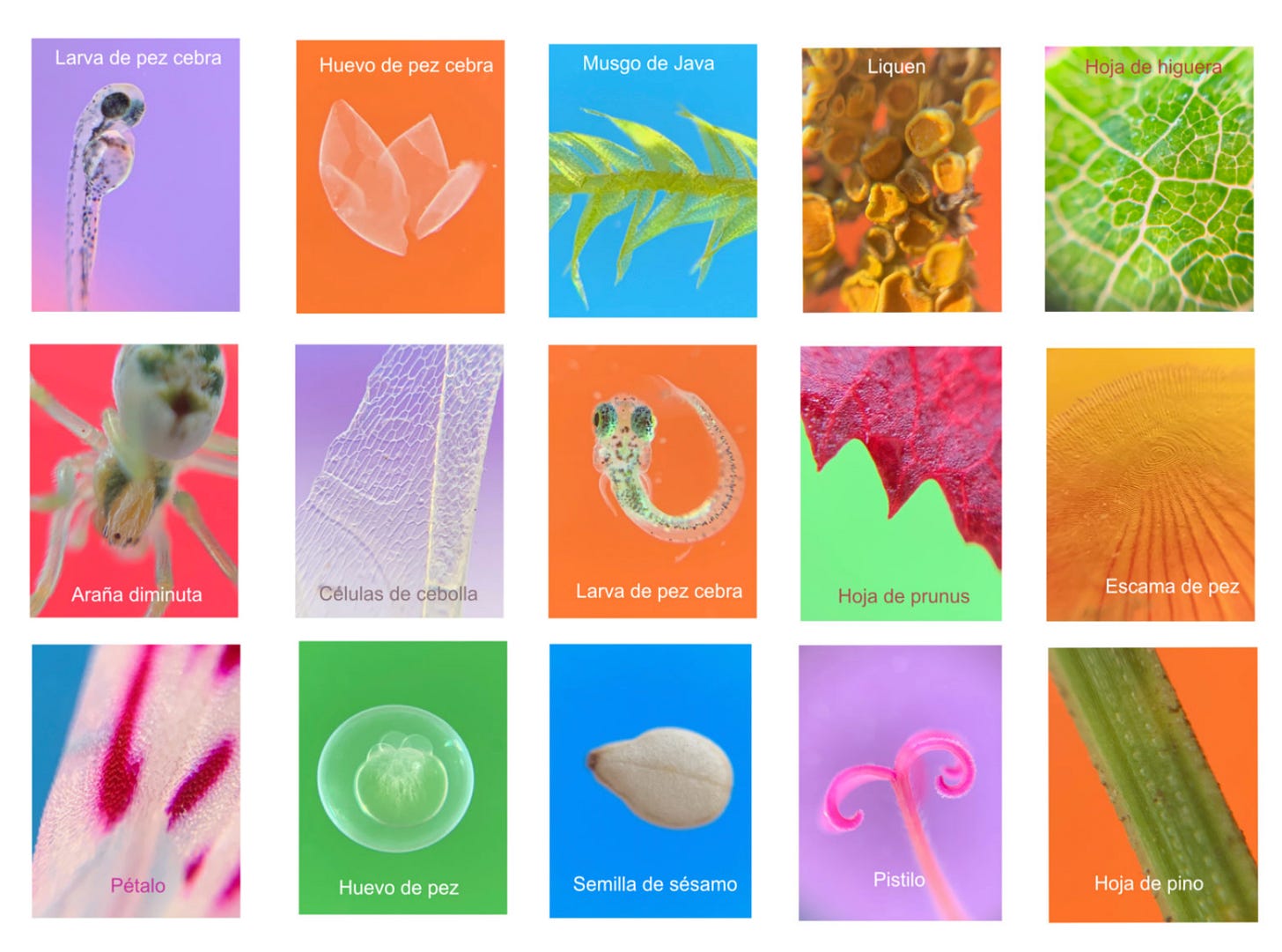Nada más acceder al Club podrás acceder a todos los recursos (proyectos, vídeos, libros…) que he ido haciendo durante estos años que llevo con Aprende con Danio.
No sé si dicho así se entiende lo suficientemente bien todo lo que implica, así que en estos días te voy a hacer un repaso de todos los materiales que incluye. A parte de esto, iré añadiendo nuevo material que se irá generando según fluyan las inquietudes de mis pequeñ@s científic@s verdader@s.
Lo primero que creo que todo científic@ que se precie debe tener es un microscopio. Como los microscopios que venden para niñ@s suelen ser bastante caca, lo que vamos a hacer es construirnos el nuestro propio.
Si llevas tiempo por aquí ya sabes que tengo un proyecto llamado haz tu propio microscopio. En el te explico cómo hacer un microscopio que funcione con tu móvil y con el que puedas ver cositas así:
Funciona con el móvil y te lo puedes llevar a tod@s sitios. Yo lo llevo siempre a todos mis viajes y excursiones.
La cara de sorpresa que se queda al utilizarlo es más o menos esta:



He hecho muchos talleres y me lo he llevado a muchos sitios y te puedo asegurar que la reacción es muy similar.
Da igual la cultura.
Da igual la edad.
Siempre sorprende. No hay fallo.
Cuando lo hagas te van a entrar unas ganas locas de verlo todo por ahí.
Ahora, ¿qué estás viendo?
Pues para empezar en el Club tendrás acceso a algunos “experimentos” muy bien explicados y guiados:
Células de una cebolla:
Todos los seres vivos estamos formados por unos ladrillos llamados células:
tú,
tu perro,
una linda mariposilla
y también las plantas.
De hecho en las plantas las células se ven especiamente bien.
En este experimento te cuento la receta para ver las células de la cebolla.
Te lo explico con:
Un vídeo animado de 5:03 minutos con un tutorial paso a paso para ver las células de la cebolla.
Cuaderno de laboratorio para científic@s verdader@s.
PDF descargable de 17 páginas para que lo imprimas y reflexionéis sobre todo lo aprendido.
Plumas
Las aves tienen el cuerpo recubierto de...
Plumas
Y si las miramos al microscopio las veremos como en la foto.
Pero, ¿porqué tiene esa estructura?
¿para qué usan las plumas las aves?
¿por qué los patos no se mojan?
¿es igual la pluma de un búho que la de una urraca?
¿porqué a un abrigo le llamamos plumas?…
Te lo explico con:
Un vídeo de 5:23 donde te enseño cómo observar las plumas al microscopio y te respondo a todas estas preguntas
Protozoos
Hay muchos seres diminutos, billones, trillones… que viven con nosotros
y que no los vemos a simple vista.
No sé si son bondadosos o no, pero tienen grandes civilizaciones en su dimensión
y se las apañan para vivir con una sola célula.
Se llaman protozoos y son super interesantes.
Te enseño a cultivarlos y a observarlos.
Te lo explico con:
Un vídeotutorial paso a paso para cultivar protozoos y verlos con el microscopio.
Estomas de la morera
Tú respiras por la nariz. Las plantas también respiran como tú.
Pero no tienen nariz, aunque en eso ya te has fijado, ¿verdad?
Lo hacen por unos agujeritos diminutos llamados estomas.
Aquí te enseño como verlos con el microscopio
Te lo explico con:
Un vídeotutorial paso a paso para observar los estomas de la morera
(¡con laca de uñas!)
Entonces, si estás en un colegio o en un instituto, ya tienes como para ocupar un par de meses de laboratorio sólo con eso. Y hacer un acompañamiento precioso cuando trates los animales, o las células, o los organismos unicelulares.
Si estás en tu casa, vas a tener un aliado imprescindible siempre que salgáis de excursión y no va a quedar un rincón de tu casa ni un bichito del jardín sin ver con ese aparatito.
Todo esto lo puedes comprar por separado si quieres, pero te costará más de 120 euros. Sin embargo si eres del club podrás tener acceso a todos estos materiales por 20 euros al mes (y otros muchos valorados en más de 1500 euros).
Mira qué otras cosas ofrece aquí:
20 euros al mes para familias, 100 para colegios.
Te podrás apuntar a partir del día 9 de febrero.
Un abrazo
Txus
As soon as you access the Club you will be able to access all the resources (projects, videos, books...) that I have been doing during these years that I have been working with Learn with Danio.
I don't know if it's clear enough what it implies, so in these days I'm going to make a review of all the materials included. Apart from this, I will be adding new material that will be generated as the concerns of my little true scientists flow.
The first thing I think every self-respecting scientist should have is a microscope. Since the microscopes they sell for kids are usually pretty crappy, what we are going to do is to build our own.
If you have been around here for a while you already know that I have a project called make your own microscope. In it I explain how to make a microscope that works with your cell phone and with which you can see little things like this:
It works with your cell phone and you can take it everywhere. I always take it with me on all my trips and excursions.
The surprised face you get when you use it is more or less like this:
I have done many workshops and I have taken it to many places and I can assure you that the reaction is very similar.
No matter the culture.
No matter the age.
It always surprises. There is no failure.
When you do it, you're going to want to see everything out there.
Now, what are you watching?
Well, to start in the Club you will have access to some very well explained and guided “experiments”:
Cells of an onion:
All living beings are made up of bricks called cells:
you,
your dog,
a cute little butterfly
and also plants.
In fact, in plants, cells look especially good.
In this experiment I tell you the recipe to see onion cells.
I explain it with:
A 5:03 minute animated video with a step-by-step tutorial to see onion cells.
Lab notebook for real scientists.
A 17-page downloadable PDF for you to print out and reflect on what you've learned.
Feathers
Birds have their bodies covered with...
Feathers
And if we look at them under the microscope we can see them like in the picture.
But why do they have this structure?
What do birds use feathers for?
Why don't ducks get wet?
Is the feather of an owl the same as that of a magpie?
Why do we call a coat a feather coat?
I explain it to you with:
A 5:23 video where I show you how to look at feathers under a microscope and answer all these questions.
Protozoa
There are many tiny beings, billions, trillions... that live with us and that we do not see with the naked eye.
and we don't see them with the naked eye.
I don't know if they are kind or not, but they have big civilizations in their dimension
and they manage to live with only one cell.
They are called protozoa and they are super interesting.
I teach you how to grow them and observe them.
I explain it to you with:
A step-by-step video tutorial on how to grow protozoa and view them under a microscope.
Mulberry stomata
You breathe through your nose. Plants also breathe like you.
But they don't have noses, although you've noticed that, right?
They do it through tiny holes called stomata.
Here I show you how to see them under a microscope.
I explain it to you with:
A step-by-step video tutorial for observing mulberry stomata.
(with nail polish!)
Then, if you are in a school or high school, you already have enough to occupy a couple of months of lab just with that. And make a precious accompaniment when you deal with animals, or cells, or unicellular organisms.
If you are at home, you will have an indispensable ally whenever you go on an excursion and there will not be a corner of your house or a little bug in the garden without seeing it with this little device.
You can buy all this separately if you want, but it will cost you more than 120 euros. However, if you are a member of the club you can have access to all these materials for 20 euros per month (and many others valued at more than 1500 euros).
See what else they offer here:
20 euros per month for families, 100 for schools.
You will be able to sign up from February 9th.
A big hug
María








